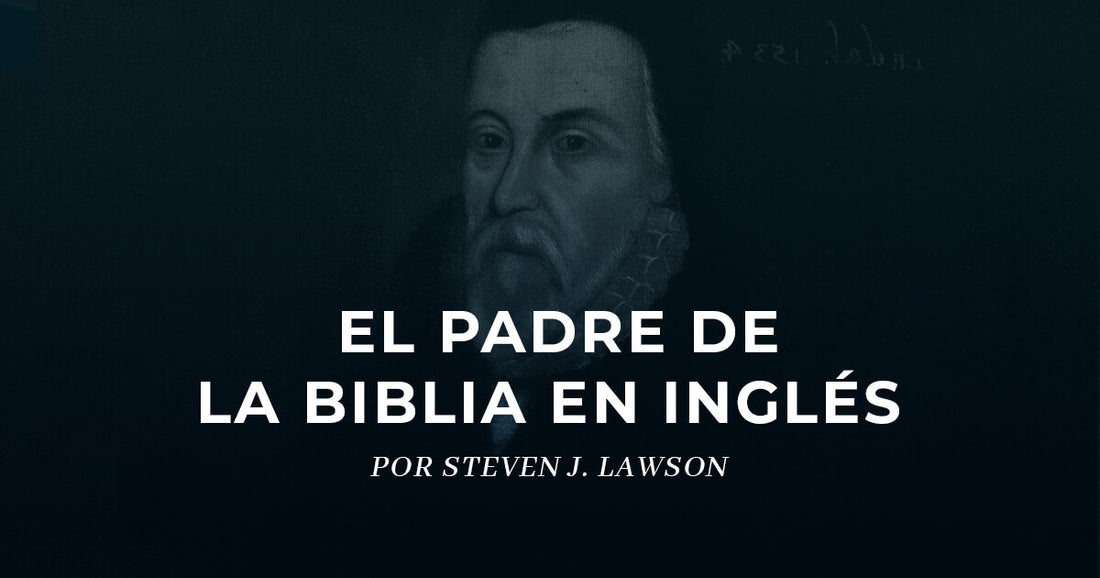
William Tyndale: Reformer and Bible translator
Share
Placed prominently in my study, as if looking over my right shoulder, is the image of an imposing portrait of the great Bible translator, William Tyndale.
The original work, painted in oil on canvas, comes from the brush of an anonymous artist. It was painted in the late 17th or early 18th century, and the original now hangs in the National Portrait Gallery in London. Tyndale appears in the portrait seated, dressed entirely in black, and surrounded by a subtle dark brown background. His face and hands seem to glow in the light of a candle that is hidden from view.

Tyndale's left hand balances a book, keeping it horizontal so it doesn't fall. This book is a Bible, the collection of divinely inspired writings to which Tyndale devoted his life to translating from Hebrew and Greek into English. His right hand appears to rest on a dark table, while his right index finger points decisively at the Bible. Tyndale is diverting the viewer's attention away from him and, rather, drawing all eyes to this sacred Book in which he firmly believed and to which he dedicated his entire life.
Below the Bible, the artist has painted an unfurled banner that appears to be suspended in the air. What is written in Latin on the banner indicates that Tyndale is an Oxford and Cambridge academic: Hac ut luz tuas dispergam Roma tenebras sponte extorris ero sponte sacrificium. This means: “To drive away the Roman darkness with this light, I will consider the loss of land and life light.” This courageous message represents Tyndale's life mission. By translating the Bible into English, this brilliant linguist lit the flame that would dispel England's spiritual darkness. Tyndale's translation of the Scriptures unveiled the divine light of biblical truth that would shine across the English-speaking world, ushering in the dawn of a new day.
“To drive away the Roman darkness with this light, I will consider the loss of land and life light.”
In the background of the portrait, behind Tyndale, are the words Guilielmus Tindilus Martyr . This is the Latin translation of this scholar's first and middle name, along with the word martyr, identifying the high cost Tyndale paid to bring Scripture into the language of his countrymen. This heroic figure died a martyr in 1536, strangled to death with an iron chain, then his corpse was cremated and exploded with gunpowder scattered around his charred body.
At the bottom of the portrait, there is a box with an explanation of Tyndale's martyrdom. The words are in Latin and this is their translation:
This painting represents, as much as art can, William Tyndale, once a student of this Hall [Magdalen] and its ornament, who, after establishing here the happy beginning of a purer theology, devoted his energies to translating the New Testament and the Pentateuch into the common language in Antwerp. This was a work so immensely oriented toward the salvation of his countrymen that he was rightly called the Apostle of England. He won his martyr's crown at Vilvoorde, near Brussels, in 1536. A man—if we can even believe his adversary (the Emperor's Attorney General)—learned, pious and good.
The irony of this portrait is that Tyndale never posed for such a depiction. To protect his anonymity, he could not reproduce his facial appearance on canvas. The work he carried out had a price too high to allow him to be recognized. Only after his horrible death could Tyndale become known.
This portrait of Tyndale hangs in my study as a constant visual reminder of the priceless treasure that rests on my desk: the English Bible. He emphasizes the fact that when he preached his truths, spiritual light is being sent into this dark world. Furthermore, this portrait testifies to me of the great price required to reveal the truth of the Bible in this time blackened by sin.
When Tyndale entered the world scene, England lay covered in a dark night of spiritual darkness. The church in England remained enveloped in the midnight of spiritual ignorance. The knowledge of Scripture had almost become extinct in the country. Although there were some twenty thousand priests in England, it was said that they were not even able to translate a single line of the Lord's Prayer. The clerics were so sunk in a quagmire of religious superstition that they had no knowledge of the truth. The only Scriptures in English were a few hand-copies of the Wycliffe Bibles, translated from the Latin Vulgate in the late 14th century. The Lollards, a small group of brave preachers and followers of Wycliffe, illegally distributed these banned books. The mere possession of Wycliffe's translation led many to suffering. Some even faced death.
Parliament passed a law known as the De haeretico comburendo in 1401, which, as its title indicates, legalized the burning of heretics at the stake. Because the Lollards were perceived as a threat, translating the Bible into English was considered a capital crime. In 1408, Thomas Arundell, the Archbishop of Canterbury, wrote the Oxford Constitutions, which prohibited any translation of the Bible into English unless authorized by the bishops:
It is a dangerous thing... to translate the text of the Holy Scriptures from one language to another, because in translation the same meaning is not always maintained... Therefore, we decree and ordain that, henceforth, no man by his authority translate any text of Scripture into English or any other language... No man can read such a book... either in part or in whole.
Even teaching the Bible illegally in England was considered a crime worthy of death. In 1519, seven Lollards were burned at the stake for teaching their children the Lord's Prayer in English. Spiritual night had fallen over the entire English land. The darkness that covered her could not have been starker.
At the same time, the fires of the Reformation were burning in places such as Wittenberg and Zurich, and could not be contained. Sparks of divine truth soon leaped across the English Channel and lit the dry sticks in England. By 1520, scholars at Oxford and Cambridge were reading and discussing Luther's works. This flame was fanned by the availability of Erasmus's New Testament in Greek, which was accompanied by its Latin translation in 1516, a year before Luther published his ninety-five theses. This resource was very valuable to scholars who read Greek and Latin. But it was of no use to the average English man, who read neither language. If the Reformation was to come to England, it would not be enough to simply shout sola Scriptura . There had to be a translation of the Bible into the English language for the people to read. But how could it happen?
In this dark hour, God raised up William Tyndale, a peerless man who possessed extraordinary linguistic abilities combined with an unwavering devotion to the Bible. He was a renowned academic, expert in eight languages: Hebrew, Greek, Latin, Italian, Spanish, English, German, and French. He had an unsurpassed ability to work with the sounds, rhythms and senses of the English language. But in order to carry out his translation work, he would be forced to leave his native England, never to return. This tenacious figure would live in hiding as a condemned heretic and a persecuted fugitive for the last twelve years of his life. He would ultimately pay the ultimate price by giving his life to martyrdom to grant his countrymen the New Testament and half of the Old Testament in English. His great feat of translating the Bible into English from the original Greek and Hebrew had not been accomplished until then. This prominent reformer would become the most significant of the early English Protestants.

